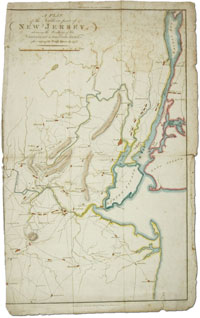
Long Island's role in the Revolutionary War was very important. After the Continental Army's victory in Boston, the British had to
set their sights elsewhere. American General George Washington anticipated that the British would aim for New York because of its
strategic location. As he had expected, the British came to New York in August, 1776 and the Battle of Long Island was fought on the 27th
day of that month. The Continental Army fought valiantly, but was defeated by the British and forced to evacuate to Manhattan. Long
Island fell under British control and would remain occupied by them until 1783.
The map, A plan of the Northern part of New Jersey showing the positions of the American and British armies after crossing the
North River (the Hudson), must represent the area after the Battle of Long Island because, among other troop movements, it
characterizes George Washington's plan for a military presence on the Jersey side of the North River after the fall of Long Island.
In a letter to Brigadier General Mercer, New York, 3 September 1776, Washington wrote: "From the present complexity of our affairs,
it appears to me that the most salutary consequences may result from our having a strong encampment at the post on the Jersey side of
the North River, and that it is of utmost importance." According to this document, by November 1776, Mercer's troops were already in
place.
This historic Revolutionary War period map, watermarked with the date 1806, is the work of Samuel John Neele (1758-1824) an
important and prolific British engraver and cartographer. The copper plate color engraving was produced for the book, The Life of
Washington: with curious anecdotes equally honourable to himself, and exemplary to his young countrymen, originally published in
1800 by Mason Locke Weems. Weems' publication, noted for creating the mythology surrounding Washington, is considered a test-case in
American historiography. Among the tales he included, Weems immortalized Washington as the young boy who chopped down the cherry tree,
"never to tell a lie." Frequently plagiarized over the years, this popular book with its abbreviated title
The Life of Washington, had already reached its 80th printing by the beginning of the twentieth century.
Bibliography
E. Benezit, Dictionnaire critique et documentaire des peintres, sculpteurs, dessinateurs et graveurs, v.7,
Paris, 1976; BNQ-Cartes geographiques-Neele, John Samuel, 1758-1824, available at http://www.bnquebec.ca/cargeo/htm/a123.htm
[accessed 18 December 2003]; Devon Library Services, Etched on Devon's Memory: available at http://www.devon.gov.uk/library/
locstudy/etchbiol.html [accessed 18 December 2003]; P. Longmore, The Invention of George Washington, Berkeley, 1988; J.
Marshall, The Life of George Washington, v.2, Virginia, 1926; J. Sparks, The Writings of George Washington,v. 3&4,
Boston, 1834; M. Weems, The Life of Washington, ed. Marcus Cunliffe, Cambridge, 1962; W. Woodward, George Washington: The
Image and the Man, New York, 1946.
|

